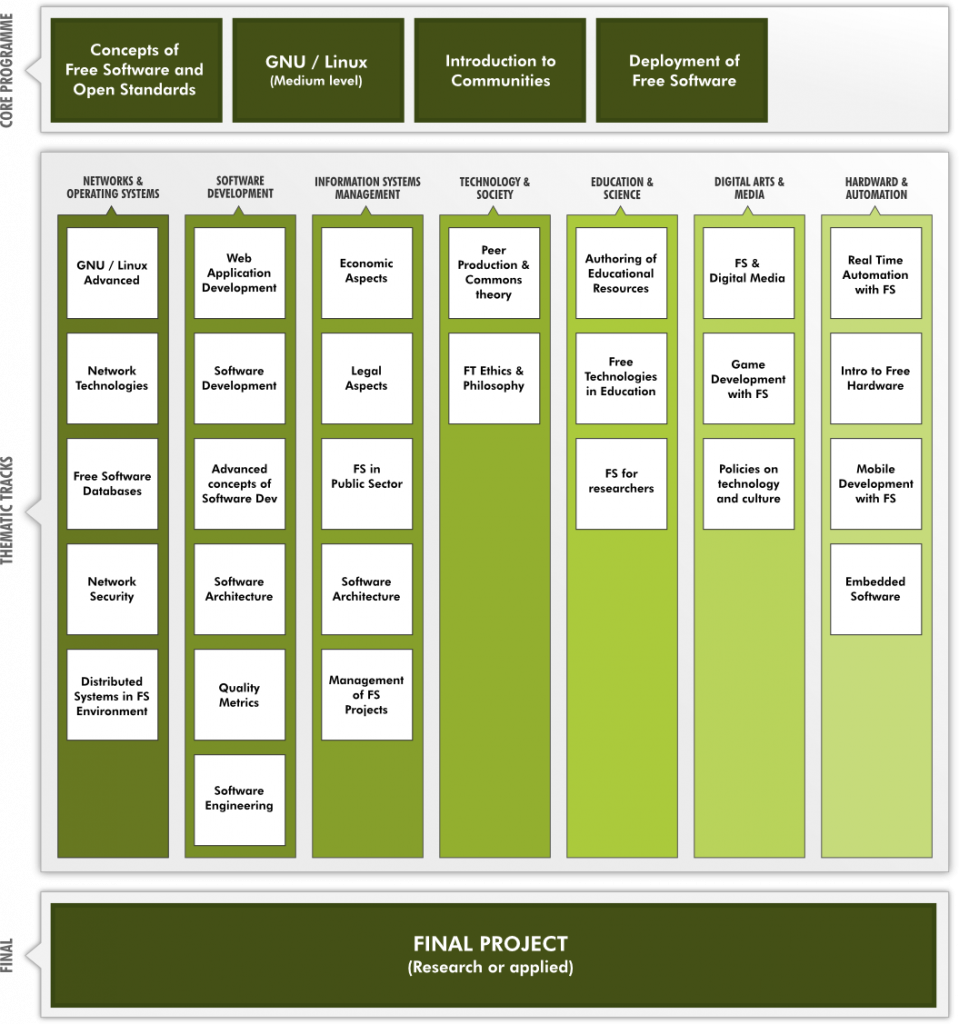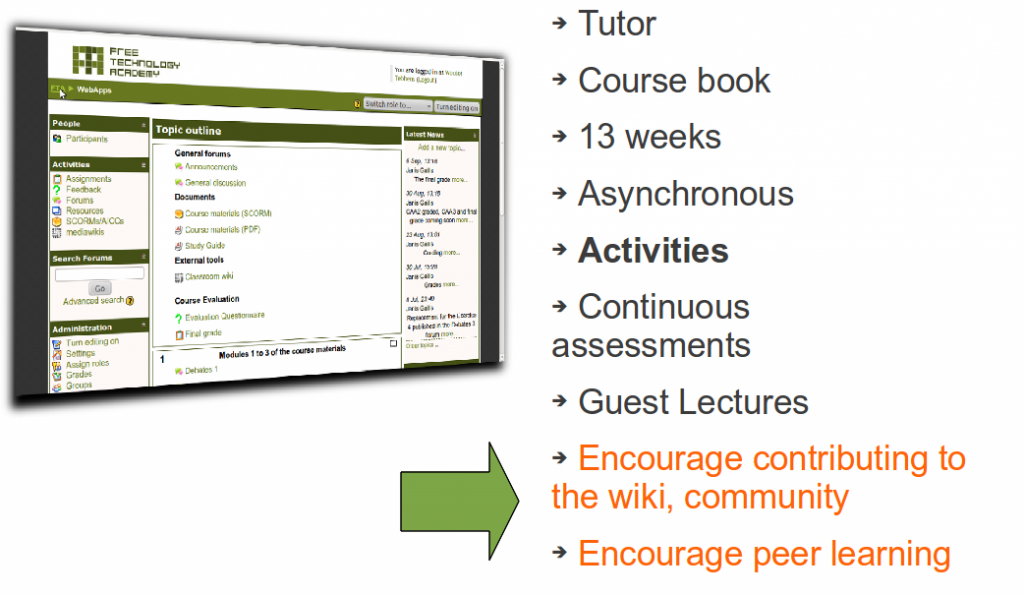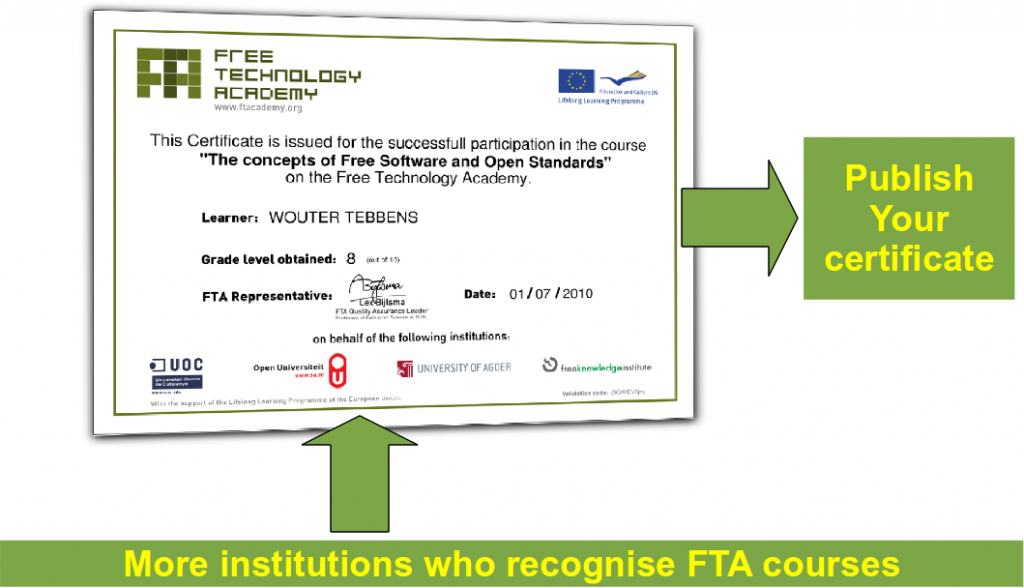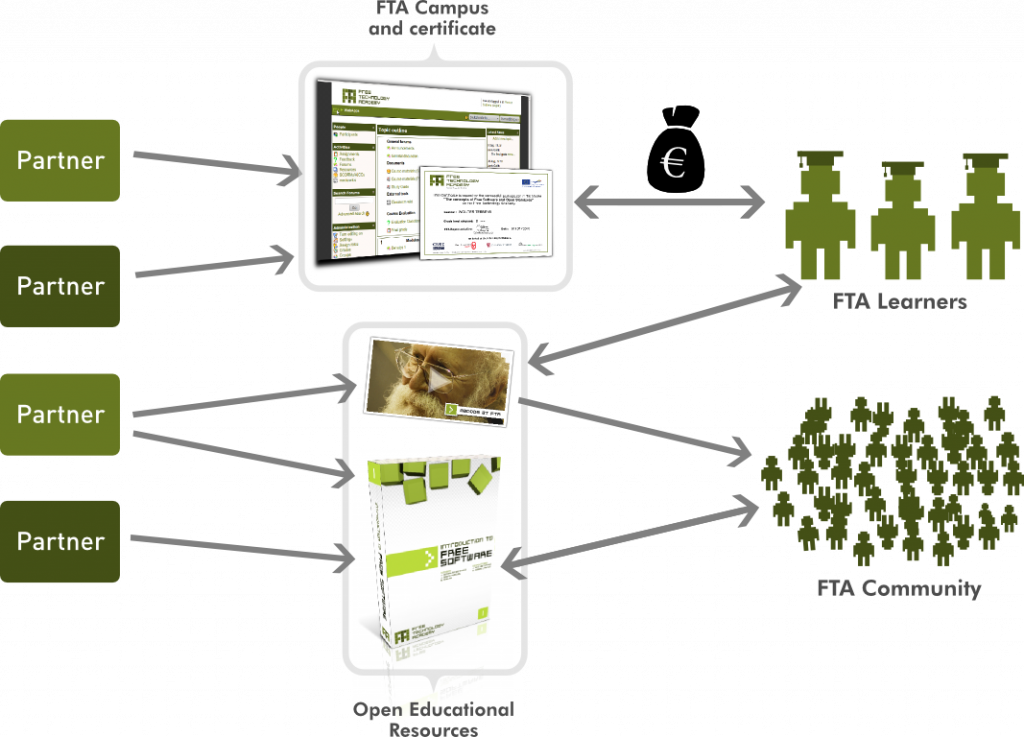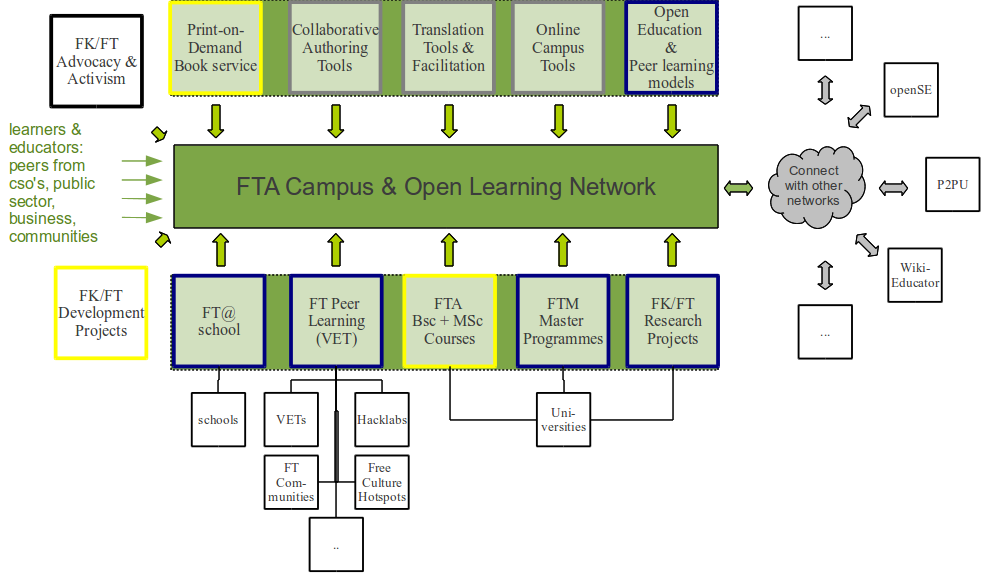A vision for the FTA
Recently we came together with the partners of the Free Technology Academy at the Open University Netherlands in Heerlen to discuss strategies and concrete plans to go forward. In this post I will try to explain the main aspects of the vision we discussed in the session “Evolving Free Technology Education together. A vision for the Free Technology Academy.” We formulated thé fundamental question that we wanted to answer as a group to define the strategy for the FTA: “Where do we want the FTA to be in 1, 5 and 10 years?” We started by recognising the main foundations and aspects that make the FTA unique.
FTA's Foundations
The FTA’s foundations are defined first by its mission and objectives. At a high level, the FTA strives to:
- contribute to a society that permits all users to study, participate and build upon existing knowledge without restrictions;
- contribute to the building of a critical mass in the use of Free Software and Open Standards.
At a more concrete level, the FTA aims to:
- upgrade knowledge on Free Software and Open Standards of ICT professionals, learners, teachers and decision makers;
- build a sustainable Free Technology Academy;
- build a network of partners to share the costs and benefits of education on free technologies.
What makes the FTA unique?
There are many educational programmes out there, and certainly very interesting ones. But let us recognise for a moment what makes the FTA different.
First of all running an academy like the FTA is different from many other educational programmes, for it is a joint effort between different partners in different countries. This poses new challenges to the processes to run the Academy and not in the least to assure the quality of running the courses and producing and maintining the course books. While it means adaptations to standard internal processes, it is also an opportunity to become better and share the burden of running a specialised programme over more shoulders.
It is also different because of its open publication under free licenses of all course books. That has led to a substantial success during the pilot in 2010, with 161 (paid) enrolments and 100.000 (free) downloads of complete course books. The economic challenge is to have sufficient income from the paid enrolments, from the learners who are interested in obtaining a tutor supported course with formal recognition by the universities, while engaging a larg(er) part of the informal participants in the community and processes of peer production.
And not to forget the topics of the FTA’s study programme itself: Free Technologies. Very few high level educational programmes exist yet that focus on Free Software, Open Standards and Free Knowledge. A few master programmes exist, but the FTA offers the first international flavour, co-organised by a network of specialised groups and institutions. Besides, the nature of Free Technologies is multidisciplinary, which in turn is reflected by the network of partners.
The FTA is conceived as a network of partners and a community of peers. In this session we discussed about the importance and value of that, as you can read further below.
Challenges
Now these objectives poses some important challenges, especially for it’s sustainability; the three most important ones: the sustainability of 1) the course module development, for the extension of the curriculum and the maintenance of the existing course books; 2) the running of the international course programme and 3) of maintaining and extending the virtual campus.
Routes to Solution
We see as the main way forward to work together with a group of interested partners and a community of peers: enroled and informal learners, partners’ staff, external experts, people interested to engage in the exchange of knowledge and constructing knowledge in the field of Free Technologies.
Partner Network
The FTA was set up by a small group of Founding Partners (FKI, UOC, OUNL) , who assured initial seed money from the European Commission (in the form of a project grant) and a growing group of Associate Partners. There are currently 15 partners. In order to succeed building the FTA, it would be important to extend the network into different geographies.
On the one hand we should prioritise universities in different countries interested to collaborate and recognise the FTA courses. On the other hand we should find specialised communities and civil society organisations who could bring in certain knowledge and engage their memberships in the community and enrol in the course modules.
Common Master Curriculum
Our vision is to build a common master curriculum, one that can be the framework on which partner universities can base their master programmes in Free Technologies. We have brought together an initial group of interested partners, including many FTA partners and several new ones and defined a project proposal for what is called the “Free Technology Master” (see abstract).
In the FTM, we want to branch out into more subjects like digital media, real time automation, mobile development. See the building in progress of the common master curriculum in the FTA Campus Wiki.
Peer Producing Course Books
Development of course books has been very much university-driven (in-house) but we want to open it up. It could go like this: specialists begin by producing a course outline; different chapters could have different teams of authors; peers review and update.
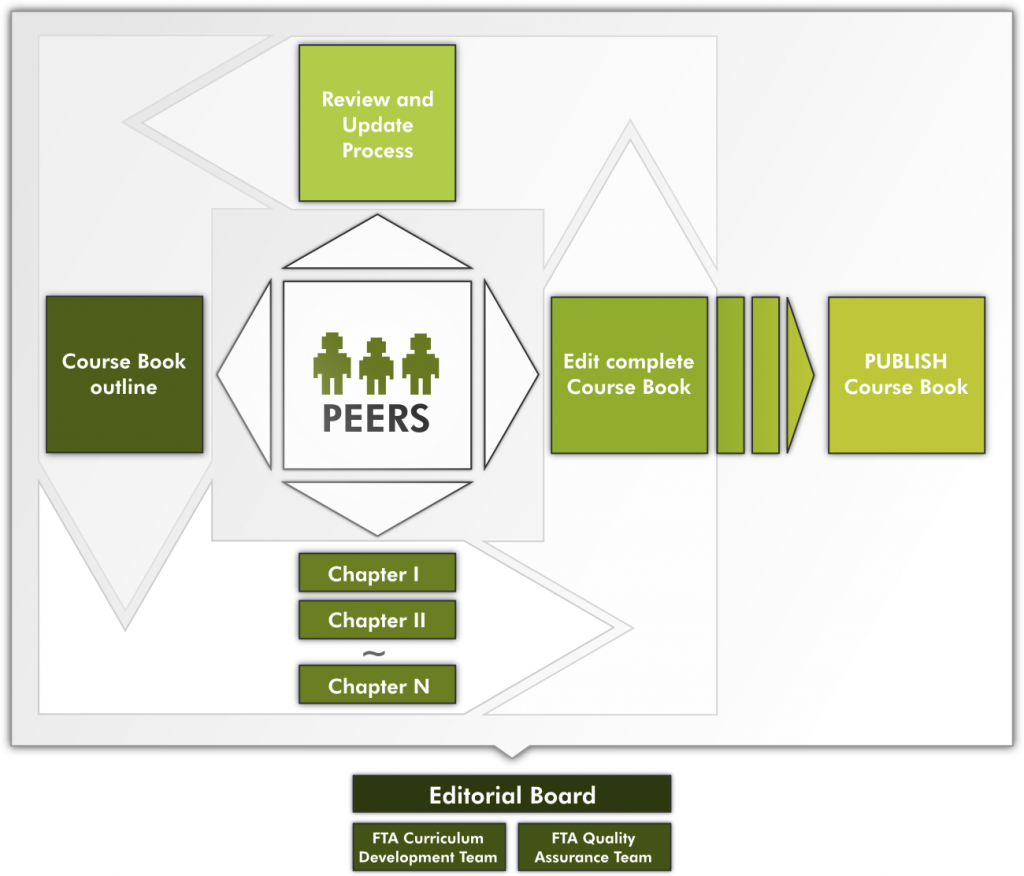 The published work is again reviewed by learners and other peers. How to organize QA and versioning systems around this? Two problems: the forking problem (doing updates in various branches), keeping track of the proper version on which exams for particular cohorts are based.
The published work is again reviewed by learners and other peers. How to organize QA and versioning systems around this? Two problems: the forking problem (doing updates in various branches), keeping track of the proper version on which exams for particular cohorts are based.
Educational Methodology
The FTA’s educational mthodology is activity based: participants get to do assignments while working through the course book. The tutor from the partner university accompanying the group of learners through the course has unfortunately limited time. And on the other hand, it would be good to have the groups and individual learners contribute (more) to the open body of free knowledge that is emerging in the community. We should therefore encourage the learners to perform their class work in the community (and in particular in the community platform) and then feedback the conclusions and results back to the class room for tutor assessment.
Another important aspect of the community is the possibility of peer learning. As Peter Sloep, Adriana Berlanga and Hanneke Potters have suggested, peer learning could be facilitated by learning networks and in concrete the so called Ad-Hoc Transient Communities. This way peers interested in the same topics find each other more easily and get presented the already existing base of knowledge on the topic they’re enquiring into. Peer learning in general can relief the tiem pressure of the academic tutors while it can provide access to much larger numbers of people, interested in participating in more informal ways.
Formal Recognition
Currently three universities have signed formal recognition agreements with the FTA to assure a smooth and predefined recognition process of FTA course certificates at those institutions. Many other universities are able to recognise FTA courses, but generally a posteriori, as the learner will need to request recognition on a one-off basis after having followed an FTA course.
Many people have asked about the recognition of the FTA by their university and it would be a step forward if more universities join the FTA and define the exact conditions of recognising FTA certificates a priori. This would help those institutions as well: FTA learners can continue their studies at those university and their students can enrich their study programmes by taking some FTA courses. In several countries the rules for electives spaces in bachelor and/or master programmes allow for taking courses elsewhere, so there should be good opportunities for the learners .. and for defining specific partnerships.
Community Portal
The FTA Virtual Campus consists nowadays of a virtual class room complemented with features for blogging, annotation of course books, a campus wiki and several other services.
In order to cater for community forming, a social network with groups, micro-blogging and other community features is in progress. This is expected to contribute to the community vision and will have a central role in our future communication.
Building a sustainable ecosystem
As you might have noticed, the keywords in our conversations are partnership, co-development, joint and shared programmes, community, network, unrestricted, free and open. We envision a network of partners that works together along lines of shared interest, producing value based on free knowledge (be it free educational materials or free software) while providing educational services. Now to make this into a sustainable ecosystem, the costs of running the formal study programme should be paid for. Participants in the formal course modules of the master level programme pay for the costs related to running that part. All the rest is in the hands of the community and partner network.
The illustration shows some of the activities that one could imagine around the current FTA Campus. We could work to extend it by:
- adding different educational levels to it, specifically for Vocational Education and Training, for primary and secondary education
- building, using and extending tools for collaborative authoring of course materials
- building, using and extending tools for the open translation of course materials
- connecting the community platform to other networks, like openSE, P2P University, WikiEducator, etc etc
Conclusions
We see the FTA as a community of peers who want to learn and share knowledge about Free Technology and in doing so contribute to the commons.
The continuation of the FTA depends on setting up community activities in the online shared spaces and attract an active population of specialists and people interesting to learn from different fields that relate to Free Technologies. We are in a good position now to work on this. To get back to the initial question of where do we want to be in 1, 5 and 10 years? Together we formulated the following mission for the years ahead.
- In one year from now we should have started with the execution of the FTM project plan to build a common master curriculum.
- In the mid term we should have established an accredited master programme with double and/or joint degrees on the basis of a common curriculum and a specialist community on the topics of Free Technologies.
- In the long term we should have extended the curriculum and study programme into adjacent fields and evolve the educational methodology to rely on horizontal and dynamically changing relations between tutors and tutees in a peer produced environment.

